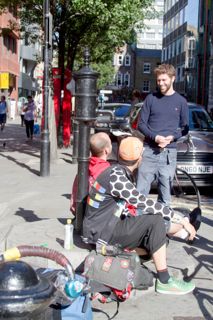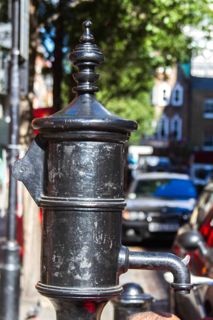There’s an odd little monument in Broadwick Street, a couple of blocks over from the Carnaby Street shopping district. It’s an old water pump, with the handle removed, across the street from a pub named after 19th century London physician John Snow.
When Snow lived in the neighborhood, it was known as Broad Street, and its pump is something of an icon in epidemiology and water. So this afternoon, Lissa and I made a pilgrimage.
The pump served the neighborhood where Snow lived. When cholera swept through the neighborhood in 1854, Snow sleuthed out the apparent fact that most of the people who died got their water from the pump, and persuaded the local Board of Guardians to remove the pump’s handle, after which the cholera outbreak ended. The conventional science of the time blamed disease on “miasmas” – essentially stinky gases from sewage, trash and corpses. The germ theory of disease had not yet taken hold. It is tempting to squish down the Broad Street pump story in the retelling in a way that makes it seem the linchpin in determining that it was germs, passed in contaminated water, that caused cholera. Remove the handle, end the outbreak, science triumphant.
In fact, the Snow story is more rich and complex than that. He’d been quietly working on his version of the germy water hypothesis for years, eventually conducting one of the first large-scale controlled epidemiological analyses ever done. Parts of London at the time were served by two water systems, one that took water from a stretch of the Thames potentially contaminated with sewage, one which took water from upstream. From David Vachon’s helpful history, here is Snow’s explanation of what we would now call “epidemiology”:
No fewer than three hundred thousand people of both sexes, of every age and occupation, and of every rank and station, from gentle folks down to the very poor, were divided into two groups without their choice, and, in most cases, without their knowledge; one group being supplied with water containing the sewage of London, and amongst it, whatever might have come from the cholera patients-the other group having water quite free from such impurity.
The people drinking poop-contaminated water were far more likely to get cholera than those getting clean water from upstream, Snow found. So when the Broad Street epidemic happened, Snow was already well on his way to collecting the data in support of his hypothesis.
Snow and the other public health officials of the day eventually even found the source of the outbreak – a baby who died of the disease in the neighborhood, and whose mother had washed the baby’s poopy diaper in a pail that she dumped in the house’s cesspool, located just a few feet from the Broad Street pump. But even with all that, the scientific establishment of the day continued to believe the miasmatic theory of disease. Here’s Vachon:
When John Snow died of a stroke on June 16, 1858, his theory about the spread of cholera had not gained any ground. The miasmists still prevailed.
There’s a replica of the pump today on the now-renamed Broadwick Street, across the street from a pub named after John Snow.
Many thanks to the folks behind the lovely UCLA School of Public Health John Snow web archive for the background used to write this post.



Good post, John. In addition to the great story on Snow, I like the old well pump as well. I have two similar pictures of period public well pumps that I’ll end up using someday.
Again, nice post! Wayne.
Are you familiar with the pump handle blog
http://scienceblogs.com/thepumphandle/?
Best